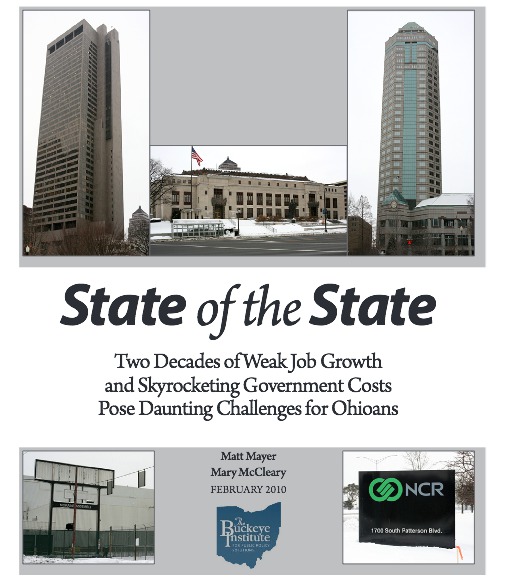 By Matt Mayer and Mary McCleary
By Matt Mayer and Mary McCleary
Executive Summary
The economic condition of Ohio is driven by three key variables: the health of the job market, the overall tax burden on Ohioans, and the cost of government. Politicians and so-called experts might quibble with such a simple view, but fundamentally an Ohio without enough jobs for its citizens who carry both a heavy tax burden and a growing government bureaucracy is an Ohio headed in the wrong direction.
As this report details, the Ohio job market is anemic and has been weak for two decades when compared to other states. The undeniable facts are:
- When the American economy boomed in the 1990s, Ohio’s job growth was the 37th best out of all fifty states and the District of Columbia. From 1990 to 2000, Ohio added a total of 720,200 private- sector jobs.
- When the American economy went bust after the Dotcom and technology crashes in 2000, as well as the September 11, 2001, terrorist attack and the housing/financial crash in 2008, Ohio lost more jobs than every state except Michigan. From 2000 to 2009, Ohio lost a total of 544,100 private-sector jobs.
- From 1990 to 2009, Ohio had the 45th worst job market in the United States. Only Connecticut, Massachusetts, Michigan, New Jersey, New York, and Rhode Island saw a worse boom-to-bust cycle.
- In roughly nineteen years, the number of non-farm, non-governmental jobs in Ohio increased by a mere 176,100, or 4 percent, which averages just over 9,000 jobs per year in a state of over 11.4 million people.
We found that states with Right to Work laws had stronger and more sustainable job growth over those nineteen years. Specifically, the twenty-eight states that force workers to join a union had an average increase in jobs from 1990 to 2009 of 17. 5 percent, which is less than 1 percent per year. In comparison, the twenty-two states with Right to Work laws that protect a worker’s economic freedom had an average increase in jobs from 1990 to 2009 of 38.5 percent, or over 2 percent per year and more than twice as much job growth as states that force workers to join unions. The fifteen states with the lowest job growth from 1990 to 2009 were all states that force workers to join unions (from lowest: -4.1 percent to 14.2 percent); whereas, eleven of the fifteen states with the highest job growth from 1990 to 2009 were states that protected a worker’s economic freedom (from highest: 90.4 percent to 33.8 percent). These Right to Work states pose long-term challenges to Ohio as it fights for jobs.
On taxes, despite attempts at tax reform that have largely moved around the deck chairs on the Titanic, Ohio’s overall tax burden ranks among the most oppressive in America. Ohio’s state and local tax burden is the 7th highest in the U.S. — a significant jump from its 29th highest ranking in 1990. Ohio’s business tax climate is the 47th worst. In a report that evaluated all of the states’ economic outlook based on seven factors, Ohio was ranked 45th with only New Jersey, Maine, Rhode Island, Vermont, and New York in worse shape.
Finally, on the cost of government, the number of government jobs in Ohio increased by 10.5 percent from 714,000 to 789,100 from 1990 to 2009. Even worse, government budgets accelerated at a pace far in excess of inflation, driven in part by gold-plated compensation packages for public employees. As highlighted in this report, federal workers make significantly more than their private-sector neighbor in 87 out of 88 counties; state workers make much more than their private-sector neighbor in 85 out of 88 counties; and local workers make more than their private-sector neighbor in 57 out of 88 counties.
These three data points lead to one sobering conclusion: If Ohio wants a vibrant job market, our elected officials must stop nibbling on the margins and put in place policies that allow businesses of all sizes and industries to grow and create jobs. By making hard choices that defang entrenched interests, our government can send a clear message that unequivocally tells Ohioans and the business community across America that Ohio is a place where businesses and their employees will face low tax burdens and effective, cost-contained government.
The failure to take these prudent actions in the face of systemic economic weakness will only ensure that more Ohio businesses move to states where they create jobs free of artificially expensive labor costs, inflexibility, and an overly burdensome government. Ohio has become a state where private-sector workers live among neighbors who work for government. Those government workers work fewer hours, but make more money, receive better and cheaper health care, have job security, and can retire early on pensions disconnected from economic reality.
These factors—systemically weak job growth, high tax burdens, and exploding government costs—must be fixed. Amidst all the talk about Wall Street and Washington, let us not forget a simple fact: Ohio does not have a Wall Street or a Beltway. We are comprised of several Main Streets with too many empty stores, too few jobs, and too many costly and ineffective governments. More government and higher taxes will not fix our Main Streets. The only entities that have ever created prosperity are businesses and the jobs they create. If we want to fix our Main Streets, we need businesses—of all sizes and industries—to thrive.
The read the rest of State of the State report and view citations, click here.
This report was written by Matt Mayer and Mary McCleary in 2010 at The Buckeye Institute.
